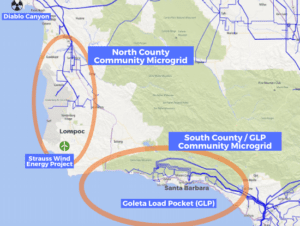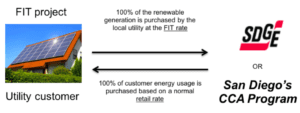
The time has come for Community Microgrids
Our Executive Director looks back on 2019 and the turning point for Community Microgrids — the moment the Clean Coalition has evolved for as we continue our groundbreaking work.
Friends,
This is the moment for microgrids. As the decade comes to a close, record wildfires in California and other disasters across the country, combined with the new normal of Public Safety Power Shutoffs (PSPS), have catapulted microgrids into the spotlight. This is the moment the Clean Coalition has evolved for as we continue our groundbreaking work on Community Microgrids – a new way of designing and operating the electric grid.

Community Microgrids go beyond traditional microgrids by keeping critical community facilities online indefinitely, thereby serving entire communities. Importantly, Community Microgrids reduce dependence on long-distance transmission lines and thereby deliver an unparalleled trifecta of economic, environmental, and resilience benefits to communities.
Read more about our work on Community Microgrids
The Clean Coalition’s showcase Community Microgrid project, the Goleta Load Pocket Community Microgrid (GLPCM), is being staged to bring renewables-driven resilience to the Goleta Load Pocket (GLP), a disaster-prone, transmission-vulnerable stretch of California coastline in Southern Santa Barbara County. This groundbreaking model for renewables-driven resilience will provide a blueprint that can be replicated in communities across the country and beyond.

2019 saw significant progress on the GLPCM. The Santa Barbara Unified School District unanimously approved an ambitious initiative with the Clean Coalition and Sage Energy Consulting to stage solar-driven microgrids and electric vehicle charging infrastructure (EVCI) at schools throughout the District.
The Montecito Union School also moved forward on a microgrid as part of the Montecito Community Microgrid, the first building block of the GLPCM.
Read more about the Goleta Load Pocket Community Microgrid
The northern portion of Santa Barbara County shares the GLP’s need for resilience – and also needs new generation sources to bolster the region for the impending closure of the Diablo Canyon Nuclear Power Plant in 2025. The Strauss Wind Energy Project (SWEP), which the Clean Coalition supports, will provide the backbone of the energy resilience needed in northern Santa Barbara County, reducing reliance on vulnerable long-distance transmission lines by introducing significant local energy resources.

The SWEP, which will enable the same amount of energy generation anticipated across hundreds of sites for the GLPCM, offers the perfect opportunity to stage a North County Community Microgrid.
Like Santa Barbara County, Northern California is facing pressing resilience needs. The City of Calistoga experienced a disruptive 48-hour PSPS event in 2018 and remains at constant risk of more, in addition to being embedded in an extreme wildfire-risk region. Early this year, the City engaged the Clean Coalition to conduct a feasibility assessment for a Community Microgrid at 6 sites, as a preemptive resilience measure. The Clean Coalition recently concluded an initial assessment, and the City is now considering next steps.

The technical solutions already exist for Community Microgrids like the ones the Clean Coalition is staging, but the lack of appropriate policies and market mechanisms is holding back their wide deployment. Hence, the Clean Coalition is working hard to promote the policies and market mechanisms necessary to proliferate Community Microgrids.
An important part of this effort is to establish a standardized Value of Resilience (VOR) methodology. While everyone understands the significant value of the indefinite renewables-driven backup power provided by Community Microgrids for critical community facilities, and provided by individual solar microgrids to any facility, there is not yet an agreed-upon methodology for quantifying VOR.

Our methodology for standardizing the Value of Resilience, VOR123, will help unleash this crucial market by showing the resilience value for critical (Tier 1), priority (Tier 2), and discretionary (Tier 3) loads.
Read more about the Value of Resilience (VOR123)
Also key to unleashing Community Microgrids is our policy leadership, which continued in 2019 with over a dozen public filings in regulatory proceedings. Supporting the widespread deployment of Community Microgrids and the distributed energy resources (DER) that drive them was our work designing state-of-the-art Feed-in Tariffs (FITs) such as one for the City of San Diego, reforming the Transmission Access Charges (TAC) market distortion, and streamlining interconnection for wholesale distributed generation (WDG).

This year saw major Clean Coalition-driven progress in these areas and more.
Read more about our 2019 policy wins
Through all our work, the Clean Coalition is accelerating the realization of our25 x 25 vision: From 2025 onward, at least 25% of newly added electricity generation capacity in the United States will be from local renewable energy sources.
Thank you for continuing to support the Clean Coalition in our pursuit of this vision. We wish you a happy holiday season and look forward to even more success in 2020 and throughout the next decade.
Sincerely,
Craig Lewis
Founder and Executive Director

